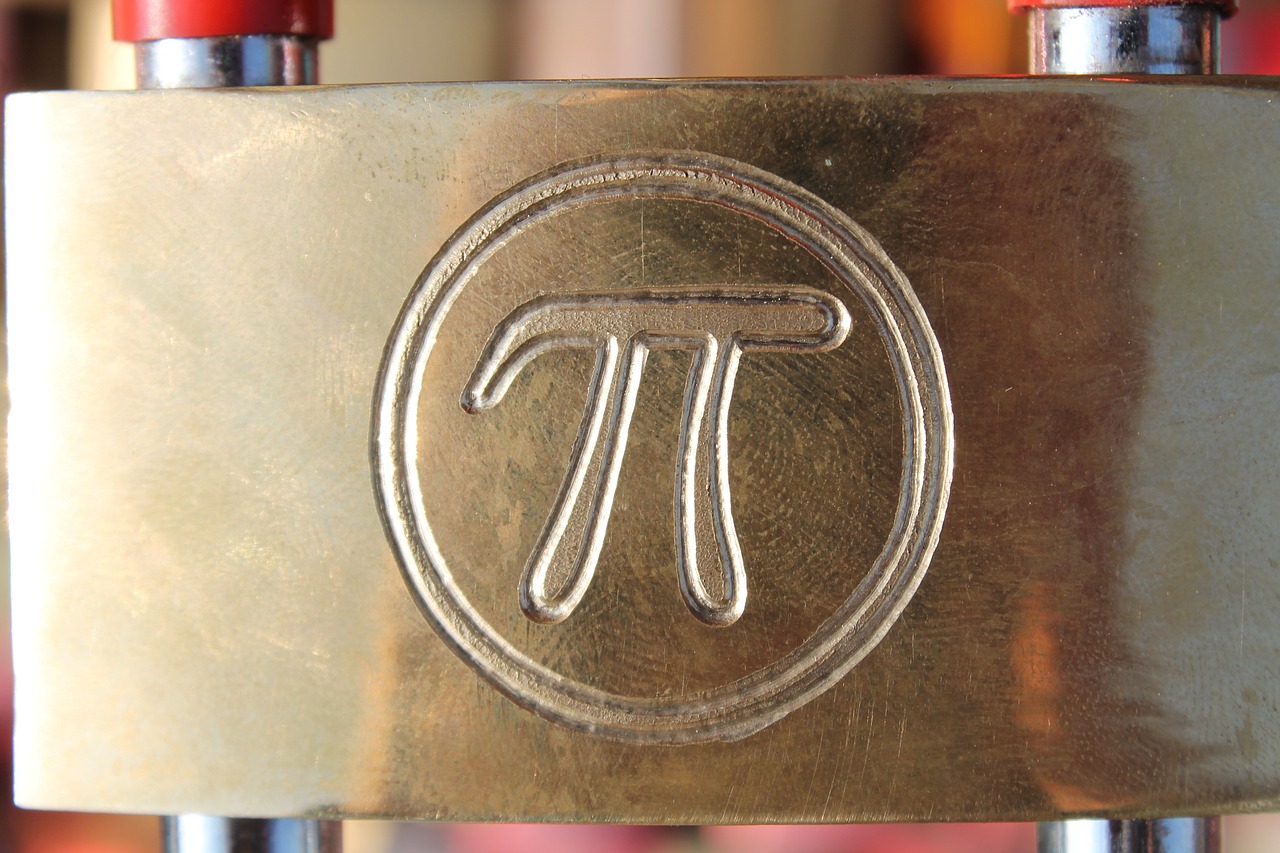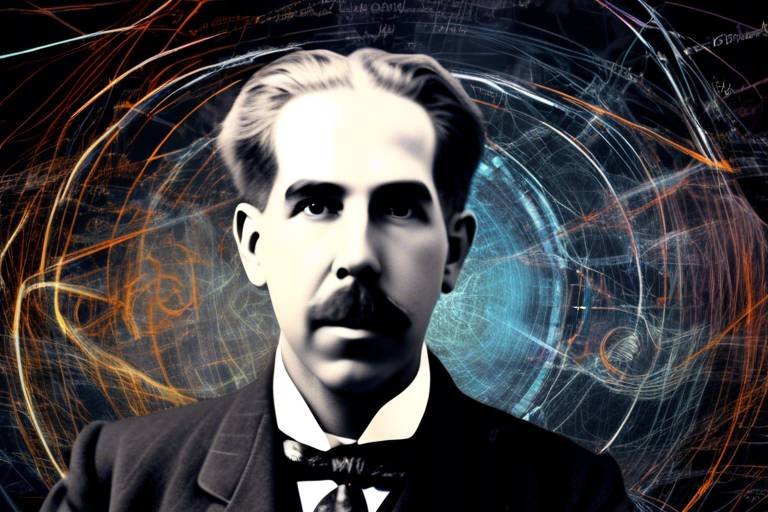The Work of Leonhard Euler in Mathematics
Leonhard Euler, a name that resonates throughout the corridors of mathematics, is often celebrated as one of the greatest mathematicians of all time. His work transcended the boundaries of mathematics, influencing various fields and laying the groundwork for many concepts that we still utilize today. Euler's contributions are not just footnotes in history; they are the building blocks of modern mathematics, shaping areas such as calculus, graph theory, and number theory. Imagine a world where the complexities of calculus and the intricacies of networks are simplified by a single mind—Euler's genius made that possible. In this article, we will delve into his remarkable contributions, exploring how his innovative ideas continue to impact our understanding of mathematics and its applications in the real world.
When it comes to calculus, Euler's influence is nothing short of revolutionary. He introduced the Euler formula, which connects complex exponentials to trigonometric functions, a relationship that is pivotal in various mathematical applications. This formula can be expressed as
e^(ix) cos(x) + i*sin(x), where e is Euler's number, approximately 2.71828. This elegant equation not only showcases the beauty of mathematics but also serves as a bridge between different mathematical disciplines, particularly algebra and calculus. Euler's work helped demystify calculus, making it more accessible to future generations of mathematicians.
Often hailed as the father of graph theory, Euler's contributions in this area began with the famous Seven Bridges of Königsberg problem. This problem posed a simple yet profound question: Is it possible to walk through the city of Königsberg and cross each of its seven bridges exactly once? Euler's solution to this problem was groundbreaking, as it introduced the concept of connectivity in networks. By representing the bridges and landmasses as a graph, he laid the groundwork for modern topology and network analysis.
The Seven Bridges of Königsberg problem is more than just a historical anecdote; it illustrates Euler's innovative approach to solving complex problems using mathematical reasoning. By abstracting the problem into a graph, he demonstrated that the solution was not about the physical layout of the bridges but rather about the connections between them. This marked the inception of graph theory, a field that has applications in various domains, including computer science, sociology, and logistics.
Building upon his earlier work, Euler introduced the concepts of Eulerian paths and circuits. An Eulerian path is a trail in a graph that visits every edge exactly once, while an Eulerian circuit is a path that starts and ends at the same vertex. These concepts are fundamental in numerous applications, including:
- Logistics and route optimization
- Circuit design in electronics
- Network analysis in computer science
By formalizing these ideas, Euler provided a framework that continues to be relevant in solving real-world problems today.
Euler's principles of graph theory are not confined to the pages of history; they are actively used in contemporary mathematics and computer science. From analyzing social networks to optimizing transportation systems, the concepts he introduced are integral to understanding complex systems. For instance, algorithms based on Eulerian paths are employed in routing data across networks, showcasing how Euler's legacy lives on in our digital age.
Euler's work in number theory is equally impressive, particularly in his exploration of prime numbers and their distribution. His investigations laid the groundwork for future explorations in this fascinating field. He introduced the Euler product formula, which relates the distribution of prime numbers to the Riemann zeta function, a connection that has profound implications in number theory. This work not only expanded our understanding of primes but also inspired subsequent mathematicians to delve deeper into the mysteries of numbers.
One of Euler's most enduring contributions is his introduction of modern mathematical notation. Before Euler, mathematics was often expressed in cumbersome and unclear ways. His introduction of the function notation f(x) and the symbol for the constant e revolutionized how mathematics is communicated. This clarity facilitated advancements in calculus and analysis, allowing mathematicians to express complex relationships with ease.
The adoption of function notation has been transformative, enabling clearer expressions of mathematical relationships. This notation is not just a convenience; it has become a fundamental aspect of how we teach and learn mathematics today. Imagine trying to solve complex equations without the clarity that function notation provides—Euler's innovations have made that daunting task manageable.
Euler's identification of the constant e as the base of natural logarithms has profound implications in calculus. The constant e appears in various contexts, particularly in growth processes and complex analysis. Its significance can be seen in fields ranging from finance to biology, where exponential growth models are crucial for understanding dynamic systems.
Euler's brilliance was not confined to pure mathematics; he also made significant contributions to physics and engineering. His development of equations that describe fluid dynamics, elasticity, and mechanics showcases the interdisciplinary impact of his work. Euler's equations of motion for incompressible fluids are foundational in fluid dynamics, influencing both theoretical studies and practical applications in engineering.
In fluid dynamics, Euler's equations provide a framework for understanding the behavior of fluids in motion. These equations are essential in various engineering applications, from designing efficient transportation systems to predicting weather patterns. The elegance and simplicity of Euler's work continue to inspire engineers and scientists alike.
His work on elasticity has been instrumental in structural engineering, offering essential insights into how materials behave under stress. This knowledge is crucial for designing resilient structures that can withstand the forces of nature. Euler's legacy in this field is a testament to the interconnectedness of mathematics, physics, and engineering.
- What is Euler's most famous formula? Euler's most famous formula is
e^(ix) cos(x) + i*sin(x)
, which connects complex numbers with trigonometric functions. - Why is Euler considered the father of graph theory? Euler is considered the father of graph theory due to his solution to the Seven Bridges of Königsberg problem, which laid the groundwork for the field.
- How did Euler contribute to number theory? Euler made significant contributions to number theory, particularly in the study of prime numbers and their distribution.

Euler's Contributions to Calculus
When we think about the evolution of calculus, one name that stands out is Leonhard Euler. His contributions were nothing short of revolutionary, reshaping the landscape of mathematics and paving the way for future advancements. Euler's work introduced several key concepts that are now fundamental to calculus, including the famous Euler formula and the exponential function. But what exactly did he do that made such a lasting impact?
To start, Euler's formula, expressed as e^(ix) cos(x) + i*sin(x), beautifully connects the realms of trigonometry and exponential functions. This formula is not just a mathematical curiosity; it's a cornerstone of complex analysis, which has vast applications in engineering, physics, and beyond. Imagine being able to seamlessly move between different areas of mathematics with a single equation! That's the kind of magic Euler brought to the table.
Furthermore, Euler was instrumental in formalizing the concept of a function. He introduced the notation f(x), which allowed mathematicians to express relationships in a clear and concise manner. This innovation was a game changer, making it easier to communicate complex ideas and facilitating the development of calculus as we know it today. Without this notation, would we have been able to advance as rapidly in mathematics? It's hard to say!
Euler's influence didn't stop there. He explored the notion of limits and continuity, which are essential for understanding derivatives and integrals. His work laid the groundwork for later mathematicians, enabling them to delve deeper into the intricacies of calculus. In fact, many of the techniques and methods we use today can trace their origins back to Euler's pioneering research.
One of the most fascinating aspects of Euler's contributions is how he bridged the gap between algebra and calculus. By introducing new functions and exploring their properties, he helped create a more cohesive understanding of how these two branches of mathematics interact. This integration has had profound implications, influencing everything from scientific research to engineering design.
In summary, Euler's contributions to calculus were not just significant; they were transformative. His innovations in notation, functions, and the interconnections between different mathematical concepts have shaped the way we understand and apply calculus today. It's awe-inspiring to think about how one mathematician's work can echo through the ages, impacting countless fields and inspiring generations of thinkers. If you're ever in doubt about the importance of Euler's work, just remember: without him, our mathematical landscape would look vastly different!
- What is Euler's formula?
Euler's formula states that e^(ix) cos(x) + i*sin(x), establishing a deep relationship between exponential functions and trigonometric functions.
- How did Euler contribute to calculus?
Euler introduced modern function notation, explored limits and continuity, and connected algebra with calculus, significantly advancing the field.
- Why is Euler's work important today?
Euler's contributions laid the groundwork for many modern mathematical concepts and techniques, influencing various fields such as physics, engineering, and computer science.

Graph Theory and Euler
When we think of Leonhard Euler, many of us might picture a man hunched over a desk filled with equations, but his legacy extends far beyond mere calculations. Euler is often celebrated as the father of graph theory, a field that has transformed how we understand connections and relationships in mathematics and beyond. His groundbreaking work is best exemplified through his solution to the Seven Bridges of Königsberg problem, which was not just a puzzle but a profound inquiry into the nature of paths and connectivity. This problem posed a challenge that seemed insurmountable at the time: could one walk through the city of Königsberg, crossing each of its seven bridges exactly once? Euler's approach to this question did not just provide an answer; it revolutionized the way we think about graphs and networks.
Euler's insight into the Seven Bridges problem led him to introduce fundamental concepts that are now cornerstones of graph theory. He defined what we now call Eulerian paths and Eulerian circuits. An Eulerian path is a trail in a graph that visits every edge exactly once, while an Eulerian circuit starts and ends at the same vertex, also traversing every edge exactly once. These definitions are crucial in various fields, including logistics, computer networking, and even game theory. To illustrate, consider the following table that summarizes these concepts:
| Term | Description | Example Application |
|---|---|---|
| Eulerian Path | A path that visits every edge exactly once. | Planning delivery routes that minimize travel distance. |
| Eulerian Circuit | A circuit that starts and ends at the same vertex while visiting every edge exactly once. | Designing efficient circuit layouts in electronics. |
But why should we care about these concepts? Well, imagine trying to connect various locations in a city without retracing your steps—this is the essence of Euler's work. His principles have laid the groundwork for modern-day applications, such as optimizing traffic flow, analyzing social networks, and even designing algorithms for computer science. The beauty of Eulerian paths and circuits lies in their versatility; they can be applied to solve real-world problems that require efficient navigation through complex networks.
Euler's contributions did not stop at defining paths and circuits. His work also delved into the connectivity of graphs, which is crucial in understanding how different nodes interact within a network. For instance, in a social network, each person can be represented as a vertex, while the friendships between them are the edges. Euler's principles help us analyze how information might flow through these connections or how communities might form based on shared interests.
In summary, Euler's pioneering work in graph theory has not only influenced mathematics but has also permeated various disciplines, including computer science, engineering, and social sciences. His innovative thinking and problem-solving methods continue to inspire mathematicians and scientists today, proving that the quest for knowledge is a journey worth taking. So, the next time you find yourself pondering over a complex network or trying to optimize a route, remember that you are walking in the footsteps of a giant—Leonhard Euler.

The Seven Bridges of Königsberg
The Seven Bridges of Königsberg problem is one of the most fascinating tales in the history of mathematics, and it serves as a perfect illustration of how Leonhard Euler approached complex challenges with innovative thinking. Imagine a city divided by a river, with two large islands and several landmasses connected by seven bridges. The challenge was simple yet profound: could one traverse all seven bridges without crossing any of them more than once? This seemingly innocent question opened the floodgates to an entirely new field of mathematics—graph theory.
Euler tackled the problem by abstracting it into a more manageable form. Instead of focusing on the physical layout of the bridges and land, he represented the landmasses as vertices and the bridges as edges in a graph. This transformation allowed him to analyze the problem using mathematical reasoning rather than geographical constraints. By doing this, he discovered that it was impossible to create a path that would cross each bridge exactly once. This conclusion was not merely an answer to a riddle; it was a groundbreaking insight that laid the groundwork for future studies in connectivity and network analysis.
To further illustrate Euler's reasoning, let’s break down the key elements of his analysis:
| Element | Description |
|---|---|
| Vertices | The landmasses (A, B, C, D) in the Königsberg layout. |
| Edges | The bridges connecting the vertices. |
| Degree of a Vertex | The number of edges connected to a vertex (e.g., how many bridges lead to a landmass). |
Euler identified a crucial rule: for a path to exist that visits every edge exactly once, at most two vertices can have an odd degree. In the case of the Seven Bridges, all four landmasses had an odd number of bridges connected to them. Therefore, it was impossible to create such a path. This was a profound realization that not only solved the problem at hand but also introduced the concept of Eulerian paths and circuits, which have become fundamental in various fields, including computer science and logistics.
Euler's work on the Seven Bridges of Königsberg did more than just solve a local puzzle; it inspired generations of mathematicians to explore the properties of graphs and networks. His method of using abstraction and representation to simplify complex problems is a timeless lesson in problem-solving. In today’s world, where we rely heavily on networks—be it social media, transportation, or even the internet—Euler's insights remain incredibly relevant.

Path and Circuit Concepts
When we dive into the world of graph theory, we find ourselves exploring the fascinating concepts of Eulerian paths and Eulerian circuits. These ideas are not just abstract notions; they represent a way of traversing a graph that can be applied to real-world problems. Imagine you’re planning a delivery route for a courier service. You want to ensure that every street (or edge) is traveled exactly once before returning to your starting point. This is where Eulerian circuits come into play!
An Eulerian circuit is a closed loop that visits every edge of a graph exactly once and returns to the starting vertex. On the other hand, an Eulerian path allows for traversing every edge exactly once but does not require returning to the starting point. To determine whether a graph has an Eulerian circuit or path, Euler established some simple rules based on the degrees of the vertices:
| Graph Type | Conditions |
|---|---|
| Eulerian Circuit | All vertices have even degrees. |
| Eulerian Path | Exactly zero or two vertices have odd degrees. |
This table summarizes the conditions required for the existence of these paths, which is crucial for anyone looking to apply Euler's concepts to practical scenarios. Picture a city planner needing to design a route that minimizes travel distance while ensuring that every street is covered. By understanding these concepts, they can optimize the routes effectively.
In addition to their practical applications, Eulerian paths and circuits have profound implications in various fields, such as logistics, network design, and even computer science. For instance, in the realm of logistics, companies can use these concepts to devise efficient delivery routes that minimize fuel consumption and time. Similarly, in computer science, algorithms based on Euler's principles can help in designing networks that are both efficient and robust.
Moreover, the beauty of these concepts lies in their simplicity and elegance. Just as a painter uses a brush to create a masterpiece, mathematicians use Eulerian paths and circuits to solve complex problems. The ability to visualize and traverse a graph in specific ways opens up a world of possibilities, making it an essential part of modern mathematics and its applications.
- What is the difference between an Eulerian path and an Eulerian circuit? An Eulerian path visits every edge exactly once and may not return to the starting vertex, while an Eulerian circuit does return to the starting vertex after visiting every edge exactly once.
- Can all graphs have an Eulerian circuit? No, only graphs where all vertices have even degrees can have an Eulerian circuit.
- How can these concepts be applied in real life? They can be applied in logistics for optimizing delivery routes, in network design, and in various computational algorithms.

Applications in Modern Mathematics
Euler's contributions to graph theory are not just fascinating historical anecdotes; they have real-world implications that permeate various fields of modern mathematics and computer science. His pioneering work laid the groundwork for understanding complex networks, enabling mathematicians and engineers to tackle problems that were once considered insurmountable. For instance, the concepts of Eulerian paths and circuits are fundamental in optimizing routes in logistics, ensuring that delivery trucks take the most efficient paths to minimize fuel consumption and time. Isn't it amazing how a problem about bridges in a small town can lead to solutions for global logistics?
Moreover, Euler's principles extend beyond mere theoretical applications; they are crucial in the realm of computer science. Algorithms that are designed to traverse networks, such as those used in social media platforms or telecommunications, often rely on Eulerian concepts. For example, when your favorite social media app suggests friends based on mutual connections, it's employing graph theory principles rooted in Euler's work. This interconnectedness highlights how Euler's ideas are woven into the very fabric of our digital lives.
In addition, the applications of Euler's graph theory are not limited to logistics and social networks. They also play a significant role in:
- Transportation Systems: Ensuring that public transit routes are efficient and cover the maximum number of stops without redundancy.
- Network Design: Creating resilient communication networks that can withstand failures and maintain connectivity.
- Game Theory: Analyzing strategies in competitive situations, where connections and paths can determine outcomes.
Furthermore, the impact of Euler's work can be seen in the burgeoning field of data science. As data sets grow increasingly complex, the ability to visualize and analyze relationships within that data becomes paramount. Euler's insights into connectivity and paths allow data scientists to model relationships effectively, leading to better decision-making and predictive analytics. The elegance of his theories continues to inspire innovations in machine learning and artificial intelligence, where understanding the structure of data is key to developing sophisticated algorithms.
In summary, the applications of Euler's work in modern mathematics are vast and varied. From optimizing logistics to enhancing data analysis, his contributions have become indispensable tools in our quest to understand and navigate the complexities of the world around us. As we continue to explore these mathematical landscapes, we owe a significant debt to Euler, whose genius has opened doors to endless possibilities.
1. Who was Leonhard Euler?
Leonhard Euler was an 18th-century Swiss mathematician and physicist who made significant contributions to various fields including calculus, graph theory, and number theory.
2. What is Euler's formula?
Euler's formula, e^(ix) cos(x) + i*sin(x), establishes a deep relationship between trigonometric functions and exponential functions, which is fundamental in complex analysis.
3. How did Euler contribute to graph theory?
Euler is often regarded as the father of graph theory, particularly known for solving the Seven Bridges of Königsberg problem, which laid the foundation for modern topology.
4. What are Eulerian paths and circuits?
Eulerian paths are trails in a graph that visit every edge exactly once. Eulerian circuits are similar but return to the starting point. These concepts are crucial for solving various real-world problems, such as routing.
5. How is Euler's work relevant today?
Euler's work remains relevant in multiple fields, including logistics, computer science, and data analysis, influencing algorithms and optimizing complex systems in our daily lives.

Euler's Influence on Number Theory
When we delve into the world of number theory, it's impossible to overlook the profound impact of Leonhard Euler. His contributions to this field were nothing short of revolutionary, setting the stage for future mathematicians to explore the intricate properties of numbers. Euler's work on prime numbers, particularly his investigations into their distribution, transformed our understanding of these fundamental building blocks of mathematics.
One of Euler's most notable achievements in number theory was his exploration of the distribution of prime numbers. He formulated the famous Euler's prime number theorem, which provides an asymptotic distribution of prime numbers. This theorem states that the number of primes less than a given number x is approximately equal to
x / log(x). This approximation not only deepened the understanding of how primes are scattered among the integers but also laid the groundwork for future studies in analytic number theory.
Moreover, Euler introduced several important concepts and theorems that are still foundational in number theory today. For example, he worked on the Euler totient function, denoted as φ(n), which counts the positive integers up to n that are relatively prime to n. This function is crucial in various areas, including cryptography, where it plays a vital role in algorithms like RSA. The totient function allows us to determine the number of integers that can be used in modular arithmetic, making it a fundamental tool in modern applications.
Euler's insights didn't stop there. He also contributed to the understanding of perfect numbers and amicable numbers. A perfect number is one that is equal to the sum of its proper divisors, while amicable numbers are two different numbers where each number is the sum of the proper divisors of the other. Euler's work on these types of numbers helped to shine a light on their properties and relationships, captivating the interest of mathematicians for centuries.
To summarize Euler's influence on number theory, we can highlight a few key points:
- Distribution of Prime Numbers: Euler's prime number theorem provided essential insights into how primes are distributed.
- Euler Totient Function: Introduced a method for counting integers that are coprime to a given number.
- Perfect and Amicable Numbers: His exploration of these concepts deepened the understanding of numerical relationships.
In conclusion, Euler's contributions to number theory are a testament to his genius and foresight. His work not only advanced the field during his time but also continues to inspire mathematicians today. The intricate dance of numbers that Euler so passionately studied remains a vibrant area of research, with his legacy echoing through the halls of mathematical inquiry.
- What is Euler's prime number theorem?
It provides an approximation for the number of primes less than a given number x, stating it's roughly equal to
x / log(x)
. - What is the Euler totient function?
It counts the positive integers up to n that are relatively prime to n, playing a crucial role in number theory and cryptography.
- What are perfect numbers?
Perfect numbers are equal to the sum of their proper divisors, a concept Euler studied extensively.

Euler's Legacy in Mathematical Notation
When we think about the language of mathematics, it’s hard not to marvel at the elegance and clarity that modern notation brings to the table. Much of this clarity can be traced back to the brilliant mind of Leonhard Euler. His innovations in mathematical notation have not only shaped the way we express mathematical ideas but have also enhanced our understanding of complex concepts. Imagine trying to solve intricate equations without the symbols and notation we use today; it would be like trying to navigate a city without a map!
One of Euler's most significant contributions was the introduction of function notation. Before Euler, mathematical expressions were often cumbersome and lacked the clarity we now take for granted. By formalizing the concept of a function as f(x), Euler provided a straightforward way to describe relationships between variables. This notation allowed mathematicians to express intricate ideas with elegance and simplicity, paving the way for future advancements in calculus and analysis. It’s akin to switching from a clunky old typewriter to a sleek, modern computer; everything just flows better!
Another groundbreaking achievement was Euler’s identification of the constant e, approximately equal to 2.71828. This constant is not just a number; it represents the base of natural logarithms and plays a crucial role in various mathematical contexts, particularly in calculus. The significance of e can be seen in growth processes, such as compound interest, population growth, and even in complex analysis. Euler's work with e demonstrates how a single constant can have profound implications across multiple domains, much like a single thread pulling together an entire tapestry.
To illustrate the impact of Euler's notation further, let’s take a look at how his contributions have influenced various branches of mathematics:
| Notation | Impact |
|---|---|
| Function Notation (f(x)) | Facilitates understanding of relationships between variables. |
| Constant e | Essential for calculus, particularly in exponential growth and decay. |
| Summation Notation (Σ) | Streamlines the representation of series and sequences. |
| Product Notation (Π) | Helps in expressing the product of a sequence of terms clearly. |
Euler’s legacy in mathematical notation doesn’t just stop at functions and constants; he also introduced several other symbols and notations that are used widely today. For instance, the summation symbol Σ for series and the product symbol Π for products have become staples in mathematical literature. These symbols allow mathematicians to express complex ideas succinctly, making it easier to communicate intricate theories and solutions. Think about it: without these notations, we would be writing out every single term, making our equations not just long but also incredibly tedious!
In conclusion, Leonhard Euler was not just a mathematician; he was a pioneer who revolutionized the way we communicate mathematical ideas. His contributions to mathematical notation have made it possible for us to explore advanced concepts with clarity and precision. Just as a good language can bridge gaps between cultures, Euler’s notation has bridged gaps in understanding complex mathematical theories. His legacy continues to inspire mathematicians and students alike, proving that the right tools can transform the way we think and solve problems.
- What is the significance of Euler's constant e?
Euler's constant e is fundamental in calculus, particularly in exponential growth and decay processes. - How did Euler influence modern mathematical notation?
Euler introduced several notations, including function notation f(x), which clarified and standardized mathematical expressions. - What are Eulerian paths and circuits?
These concepts describe traversing every edge of a graph exactly once, foundational in graph theory.

Function Notation
Function notation is one of the most significant contributions by Leonhard Euler to mathematics, and it has changed the way we express mathematical relationships forever. Imagine trying to explain a complex relationship without a clear way to represent it; it would be like trying to navigate a maze without a map. Before Euler introduced this notation, mathematicians had to rely on cumbersome and often confusing methods to convey their ideas. However, with the introduction of function notation, expressing mathematical relationships became as straightforward as pie!
Function notation is typically represented as f(x), where f is the name of the function and x is the variable. This simple yet powerful notation allows mathematicians to describe a wide range of functions and their behaviors succinctly. For instance, when we say f(x) x^2, we are clearly stating that for any input value of x, the output is the square of that value. This clarity is crucial in advanced mathematics, where functions can become increasingly complex.
One of the remarkable aspects of function notation is its versatility. It can be applied to various types of functions, including:
- Linear Functions: These are functions of the form f(x) mx + b, where m is the slope and b is the y-intercept.
- Quadratic Functions: These take the form f(x) ax^2 + bx + c, where a, b, and c are constants.
- Exponential Functions: Represented as f(x) a * e^(bx), where a and b are constants, and e is Euler's number.
This notation not only simplifies communication among mathematicians but also lays the groundwork for further advancements in calculus and analysis. For example, when we differentiate a function, we often write f'(x) to denote the derivative of f with respect to x. This notation allows for a seamless transition from understanding the function itself to exploring its rate of change, which is a fundamental concept in calculus.
Moreover, function notation has become essential in various branches of mathematics and applied sciences. It serves as a bridge connecting algebra, calculus, and even fields like physics and engineering. By providing a common language, it enables mathematicians and scientists to collaborate effectively, share ideas, and build upon each other's work. In a world where complex problems are the norm, having a clear and concise way to express functions is invaluable.
In conclusion, Euler's introduction of function notation has had a profound and lasting impact on mathematics. It not only revolutionized how we express mathematical relationships but also paved the way for future advancements in various fields. Just as a well-constructed building stands the test of time, Euler's notation continues to support the ever-evolving landscape of mathematics.

The Constant e
The constant e, approximately equal to 2.71828, is not just a number; it's a gateway to understanding the world of exponential growth and decay. Imagine you’re planting a garden. The growth of your plants can be modeled using this constant, as it represents the rate of growth in various natural processes. Euler's discovery of this constant has profound implications across mathematics, particularly in calculus and complex analysis.
One of the most fascinating aspects of e is its unique properties. It serves as the base for natural logarithms, which are essential for solving equations involving exponential growth. For example, when calculating compounded interest or population growth, the formula often involves the constant e. This relationship can be illustrated with the formula:
A Pe^(rt)
Where:
- A the amount of money accumulated after n years, including interest.
- P the principal amount (the initial amount of money).
- r the annual interest rate (in decimal).
- t the time the money is invested or borrowed for, in years.
This equation clearly demonstrates how the constant e plays a crucial role in determining how quickly investments grow over time. Without Euler’s work, our understanding of these concepts would be significantly less sophisticated.
Moreover, the significance of e extends beyond finance. In the realm of complex analysis, Euler’s formula, e^(ix) cos(x) + i*sin(x), beautifully connects the fields of trigonometry and exponential functions. This relationship is not just a mathematical curiosity; it has applications in engineering, physics, and even signal processing.
In summary, the constant e is not merely a number; it is a fundamental building block in mathematics that helps us model the natural world. Its applications span various disciplines, making it an enduring legacy of Euler's genius. Understanding e is essential for anyone looking to delve deeper into mathematics, as it opens the door to a myriad of theories and applications that shape our understanding of the universe.
- What is the value of the constant e? The constant e is approximately equal to 2.71828.
- Why is e important in calculus? The constant e is the base of natural logarithms and is essential for modeling exponential growth and decay.
- How is e used in real life? e is used in finance for calculating compound interest, in biology for modeling population growth, and in physics for wave equations.

Euler's Work in Physics and Engineering
When we think about the intersection of mathematics and engineering, one name that stands out prominently is Leonhard Euler. His contributions extend far beyond the realm of pure mathematics; they have had a profound impact on the fields of physics and engineering. Euler's work has provided the tools and frameworks that allow us to understand complex physical phenomena, making him a pivotal figure in these disciplines.
One of Euler's most significant contributions to physics is his formulation of the Euler equations of motion for incompressible fluids. These equations describe the motion of fluid substances and are foundational in the field of fluid dynamics. Imagine trying to predict how water flows through a pipe or how air moves around an airplane wing; Euler's equations make these predictions not just possible but also precise. They enable engineers and scientists to model real-world scenarios accurately, which is crucial for designing everything from aircraft to hydraulic systems.
In addition to fluid dynamics, Euler's work has significantly influenced the field of elasticity. His studies on how materials deform under stress have been instrumental for engineers. This is particularly important when designing structures that must withstand various forces, such as buildings, bridges, and dams. By understanding how materials behave, engineers can create safer, more resilient structures. Euler's insights have led to the development of critical concepts such as stress, strain, and the elastic modulus, which are indispensable in materials science.
To illustrate the impact of Euler's contributions, consider the following table that summarizes some of his key equations and their applications:
| Field | Equation | Application |
|---|---|---|
| Fluid Dynamics | Euler's Equations of Motion | Modeling fluid flow in pipes and around objects |
| Elasticity | Hooke's Law (derived from Euler's work) | Understanding material deformation under load |
| Structural Engineering | Euler's Buckling Formula | Predicting failure in slender structural elements |
Euler's influence doesn't stop there. His work on differential equations has allowed engineers to model dynamic systems, whether it's the behavior of a swinging pendulum or the vibrations in a bridge. By providing a systematic approach to solving these equations, Euler has equipped engineers with the tools necessary to tackle complex problems in mechanics and thermodynamics.
In summary, Leonhard Euler's contributions to physics and engineering are nothing short of revolutionary. His equations and theories have become integral parts of the curriculum in engineering programs around the world. Without his pioneering work, our understanding of fluid dynamics and elasticity would be far less advanced, and the designs of modern structures would lack the rigor and reliability we now take for granted. Euler's legacy continues to inspire engineers and physicists alike, as they apply his principles to innovate and solve the challenges of today and tomorrow.
- What are Euler's contributions to fluid dynamics?
Euler formulated the equations of motion for incompressible fluids, which are fundamental in predicting fluid behavior in various engineering applications. - How did Euler influence structural engineering?
His work on elasticity and material deformation has provided essential insights that guide the design of resilient structures. - What is Euler's Buckling Formula?
This formula predicts the failure of slender structural elements under compression, helping engineers design safer structures.

Fluid Dynamics
When we dive into the world of , we are essentially exploring the behavior of liquids and gases in motion. This fascinating field is not just about watching water flow or air currents; it is about understanding the principles that govern these movements. One of the most significant contributors to this discipline was Leonhard Euler, whose equations of motion for incompressible fluids laid the groundwork for modern fluid dynamics. Imagine trying to navigate a river with varying currents; Euler's work helps us predict how the water will behave under different conditions, allowing engineers and scientists to design more effective systems and structures.
Euler's equations describe how fluid particles interact with each other and their surrounding environment. These equations are derived from the fundamental principles of conservation of mass, momentum, and energy. By applying these principles, Euler was able to create mathematical models that explain how fluids flow, which is crucial in numerous applications, including:
- Aerospace Engineering: Understanding airflow over wings and fuselages to optimize flight performance.
- Hydraulics: Designing systems for transporting water and other fluids efficiently.
- Environmental Science: Predicting the dispersion of pollutants in air and water.
His equations are not just theoretical; they have practical implications that affect our daily lives. For instance, when engineers design buildings or bridges, they must consider how wind will affect their structures. Euler's insights into fluid behavior enable them to create designs that can withstand these forces, ensuring safety and longevity.
Moreover, Euler's contributions extend beyond just theoretical equations. His work has influenced computational fluid dynamics (CFD), a field that uses numerical methods and algorithms to analyze fluid flows. CFD is essential in industries ranging from automotive to biomedical engineering, helping to simulate and optimize designs before they are built. Without Euler's foundational principles, our understanding of fluid motion would be far less advanced.
In summary, the impact of Euler's work in fluid dynamics is profound and far-reaching. His equations continue to serve as a cornerstone for both theoretical research and practical applications, enabling us to navigate the complexities of fluid behavior in a myriad of contexts. As we continue to explore this dynamic field, we owe a great deal to Euler's pioneering spirit and mathematical genius.
- What are Euler's equations of motion?
Euler's equations of motion describe the relationship between the velocity field of a fluid and the forces acting upon it, allowing us to predict how fluids behave under various conditions. - How are Euler's contributions relevant today?
Euler's work laid the groundwork for modern fluid dynamics, influencing various fields such as engineering, environmental science, and aerodynamics. - What is computational fluid dynamics (CFD)?
CFD is a branch of fluid mechanics that uses numerical analysis and algorithms to solve and analyze problems involving fluid flows, heavily relying on the principles established by Euler.

Applications in Structural Engineering
When we think of the intricate dance of structures standing tall against the forces of nature, we often overlook the genius behind their design. Leonhard Euler was a pioneer in this field, and his contributions to structural engineering have paved the way for modern practices. His work on elasticity and the behavior of materials under stress is not just theoretical; it has real-world applications that impact our daily lives.
One of the most significant contributions Euler made was the formulation of the Euler-Bernoulli beam theory. This theory describes how beams bend and deform under various loads, providing engineers with the necessary tools to predict and analyze structural behavior. Imagine trying to build a bridge without knowing how the materials would react to the weight of traffic; it would be like trying to navigate a ship without a compass. Thanks to Euler, engineers can confidently design structures that are both safe and efficient.
In practical terms, Euler's principles are applied in various aspects of structural engineering, including:
- Load Distribution: Understanding how loads affect different parts of a structure ensures that materials are appropriately chosen and placed, preventing failure.
- Stability Analysis: Euler's methods help in assessing the stability of structures, particularly under dynamic loads like wind or earthquakes.
- Material Selection: His insights into material behavior guide engineers in selecting the right materials for specific applications, ensuring durability and safety.
To illustrate the impact of Euler's work, consider the design of a skyscraper. Engineers must account for numerous factors, including wind loads, seismic activity, and the weight of the building itself. By applying Euler's equations, they can predict how the structure will respond to these forces, ensuring it remains standing even in the face of extreme conditions. This predictive capability is invaluable, as it allows for the creation of resilient structures that can withstand the test of time.
| Application | Description |
|---|---|
| Load Distribution | Ensures that loads are evenly spread across a structure, preventing localized failures. |
| Stability Analysis | Evaluates how structures respond to external forces, ensuring they remain upright and functional. |
| Material Selection | Guides engineers in choosing the right materials based on their stress and strain characteristics. |
In summary, Euler's contributions to structural engineering are not merely academic; they are foundational to how we build and design today. His theories have transformed the way engineers approach construction, leading to safer, more efficient structures that can endure the challenges posed by nature. Without his insights, the skyline of our cities and the integrity of our buildings would look vastly different. It’s a testament to the power of mathematics and its ability to shape our world.
- What is Euler's contribution to structural engineering? Euler's work on elasticity and the Euler-Bernoulli beam theory has laid the groundwork for understanding how structures respond to loads.
- How does Euler's work influence modern engineering? His principles are applied in load distribution, stability analysis, and material selection, ensuring safer and more efficient structures.
- Why is stability analysis important? Stability analysis helps engineers predict how structures will react to external forces, ensuring they remain safe and functional.
Frequently Asked Questions
- What were Leonhard Euler's main contributions to calculus?
Leonhard Euler made groundbreaking advancements in calculus by introducing key concepts such as the Euler formula and the exponential function. His work effectively connected algebra with calculus, paving the way for future mathematicians to explore and expand upon these ideas.
- How did Euler contribute to graph theory?
Euler is often hailed as the father of graph theory, primarily due to his solution to the Seven Bridges of Königsberg problem. This innovative approach not only showcased his mathematical reasoning but also laid the foundational principles for modern topology and network analysis.
- What are Eulerian paths and circuits?
Euler introduced the concepts of Eulerian paths and circuits, which involve traversing every edge of a graph exactly once. These concepts are crucial for various practical applications, including logistics, circuit design, and network optimization.
- What impact did Euler have on number theory?
Euler significantly advanced number theory, especially regarding prime numbers and their distribution. His pioneering work laid the groundwork for future explorations in this field, influencing countless mathematicians who followed in his footsteps.
- How did Euler change mathematical notation?
Euler revolutionized mathematical communication by introducing modern notation, such as the function notation f(x) and the symbol for the constant e. This innovation has greatly enhanced the clarity and understanding of mathematical relationships, facilitating advancements in calculus and analysis.
- What are the applications of Euler's work in physics and engineering?
Beyond mathematics, Euler's contributions extend into physics and engineering. His equations for fluid dynamics and mechanics have become foundational in these fields, influencing both theoretical studies and practical engineering applications.
- Can you explain Euler's equations in fluid dynamics?
Euler's equations of motion for incompressible fluids are critical in fluid dynamics. They describe how fluids behave under various conditions, providing essential insights for both theoretical research and real-world engineering challenges.
- How did Euler's work influence structural engineering?
Euler's research on elasticity has had a profound impact on structural engineering, offering vital insights into how materials respond to stress. His findings guide the design of resilient structures, ensuring they can withstand various forces and conditions.



















